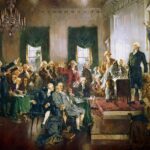By Stephen Zogopoulos, USNN World News
Independence Day, also known as the Fourth of July, is a significant holiday in the United States that commemorates the country’s declaration of independence from British rule. This day holds immense historical and cultural importance, and it is celebrated with great enthusiasm and patriotic fervor across the nation. In this article, we will delve into the history behind Independence Day and explore the various traditions that have become synonymous with this cherished holiday.
The Historical Context: The seeds of the American Revolution were sown in the 18th century, as colonists in the thirteen American colonies grew increasingly discontent with British rule. The Stamp Act of 1765, the Tea Act of 1773, and other oppressive measures imposed by the British government fueled widespread protests and resistance. The turning point came on July 4, 1776, when the Continental Congress adopted the Declaration of Independence, penned by Thomas Jefferson, proclaiming the colonies’ independence from Great Britain.
The Birth of Independence Day: The adoption of the Declaration of Independence marked the birth of a new nation, and celebrations erupted throughout the colonies. The first official commemoration of Independence Day took place on July 4, 1777, with public readings of the Declaration, patriotic speeches, and military parades. The revelry included the firing of guns, bonfires, and fireworks—a tradition that continues to this day.
Traditions and Customs:
- Fireworks: Fireworks displays have become an integral part of Independence Day celebrations. Across the country, vibrant pyrotechnic spectacles light up the night sky, mesmerizing spectators and instilling a sense of awe and national pride. Families and friends gather in parks, beaches, and open spaces to witness these dazzling displays of color and light.
- Parades: Communities organize parades to honor the nation’s history and pay tribute to those who have served in the armed forces. These processions feature marching bands, floats adorned with patriotic symbols, and participants dressed in red, white, and blue. Parades are a cherished tradition that fosters a sense of unity and patriotism among attendees.
- Barbecues and Picnics: Independence Day is synonymous with outdoor gatherings centered around delicious food and camaraderie. Families and friends come together for backyard barbecues, picnics in parks, and beach outings. Grilled burgers, hot dogs, watermelon, and apple pies are among the iconic culinary delights enjoyed on this day.
- Flag Waving and Decorations: Americans proudly display the national flag during Independence Day celebrations. Homes, streets, and public spaces are adorned with patriotic decorations, such as bunting, streamers, and banners. The flag serves as a visual symbol of unity, freedom, and national pride.
- Community Events: Many cities and towns organize community events to engage residents and foster a sense of community spirit. These events include concerts, fairs, carnivals, and sports competitions. It provides an opportunity for people to come together, celebrate, and enjoy the festivities as a collective.
Independence Day stands as a testament to the spirit of liberty and freedom that has shaped the United States. Through its historical significance and cherished traditions, the holiday serves as a reminder of the sacrifices made by previous generations and the enduring principles upon which the nation was founded. Whether it’s watching fireworks light up the sky, enjoying a picnic with loved ones, or participating in a community parade, Independence Day brings Americans together to celebrate their shared heritage and values. It is a day to reflect on the nation’s history, honor those who have fought for freedom, and rejoice in the blessings of liberty.






